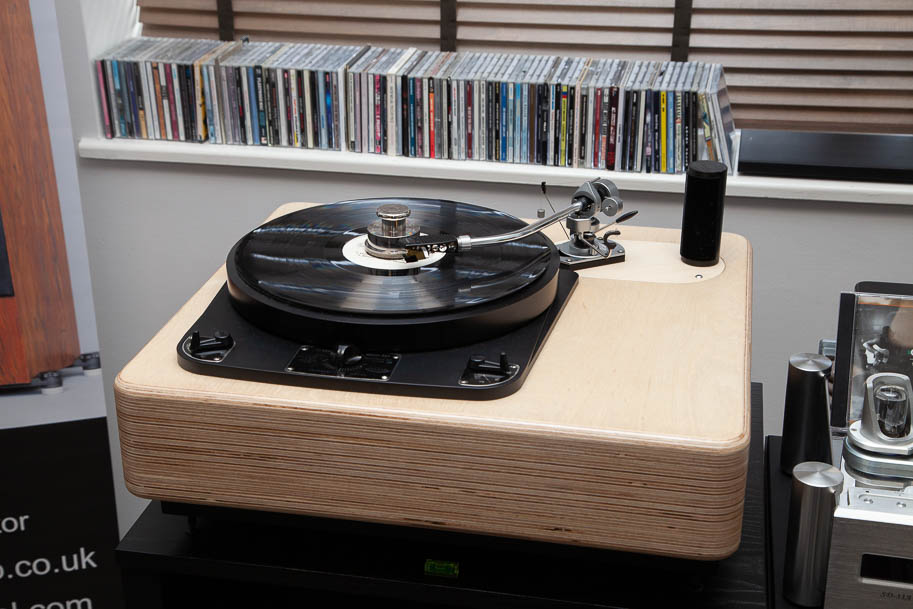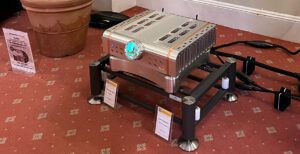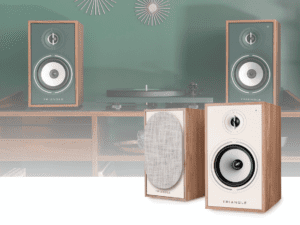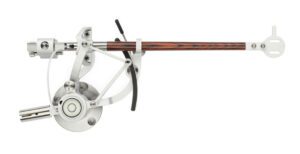
For the audio afficionado (and latterly everyone else) the LP record is one of the most iconic music formats of all time. Without it the course of reproduced music would have been very different indeed although it’s hard to predict what course it would have taken. One alternative that ran in parallel was the magnetic tape recorder, a technology developed shortly after the Shellac record. The first tape recorders were made by AEG, Germany in 1934 but tape wasn’t to become a commercial reality until 1948, when Ampex introduced its first recorder the Ampex 200 in the United States.
Coincidentally 1948 was the same year that the LP or long playing record was invented by Peter Goldmark at Columbia Records, it was a good year for developments in audio reproduction. Columbia introduced the use of vinyl and 331/33 RPM (revolutions per minute) that became the accepted speed for LPs. This gave a playing time of up to 22 minutes per side. This was a major increase on the five minute total from 78 RPM, 10” Shellac discs that were released shortly after the turn of the century by the Victor Company.
By 1948, ‘Victor’ had become ‘RCA Victor’, which decided to get in on the new format action by introducing the seven inch record. This was also vinyl and offered the same playing time as a 10” 78, while spinning at 45 RPM.
Time up
The vinyl LP not only quadrupled the playing time of a record but also offered lower noise, significantly greater dynamic range and wider bandwidth compared to 78s. The LP has a dynamic range of 65dB (or possibly 70dB, depending on which source you trust) and bandwidth that’s said to cover 7Hz to 50kHz. While many advocates of CD used to go on about ‘clicks and pops’, vinyl is a considerably quieter material than its predecessor, and a far more robust one at that. It’s ironic that CD was touted as being immune to the effects of scratches, and even strawberry jam(!), when it was introduced, because today we are aware that a scratched CD cannot be played whereas the most damaged LP will still produce sound, alongside noise produced by damage to its surface.
While the first vinyl LPs contained mono recordings this was the format that introduced stereophonic sound to the world. Stereo recordings had been made on tape and even experimentally on two 78 RPM disc cutters, but the first commercial recording to feature two channel sound from a single groove was issued by Audio Fidelity Records in November 1957. This contained music by the Dukes of Dixieland on one side and sound effects including railway trains on the other. At the time, however, there were no cartridges available that could reproduce stereo sound, until Shure introduced the M3D stereo Dynetic Cartridge in 1958. Dynetic was the company’s name for what we now call a moving magnet cartridge; a technology that Shure had developed for mono LPs in 1957.
The Stereo Era
The notion of high fidelity was prevalent in the mono LP era but the introduction of stereo to the format ushered in an era of realism that, to use today’s parlance, was genuinely next level. It brought forth an explosion of interest in sound quality from the general public and subsequently a boom time for the audio manufacturing industry. It also meant the beginning of end for substantial loudspeakers; it seemed that the home of the 1960s could cope with one large corner horn but most of them became crowded when a second speaker appeared. The result was the development of relatively compact, reflex-loaded loudspeakers in broadly the same mould as the majority of their ilk today. As Beatles fans are aware, mono continued to be a commercially popular format well into the 1960s largely because of the cost of upgrading to a stereo system. And in the eyes and ears of a few connoisseurs, mono remains the only way to enjoy genuine high fidelity today.
The introduction of the LP record revolutionised the music industry. It allowed for longer and more complex compositions, as well as improved sound quality. It also allowed for the creation of special editions and reissues of classic albums. LPs embraced by musicians and fans alike and quickly became the format of choice for record labels. The LP record also made it easier for fans to collect their favourite artists’ music. With the LP format, fans could easily collect albums and organise their music collections. And because albums were longer than singles and often included more songs, fans were able to experience more of their favourite musician’s work.
The LP went on to become the dominant format for recorded music throughout the 1960s, 1970s and early 1980s. During this time, many classic albums, such as the Beatles’ Sgt. Pepper’s Lonely Hearts Club Band, The Beach Boys’ Pet Sounds, and Bob Dylan’s Blonde on Blonde, were released and only available on LP.
Conceptual thinking
Although the album predates LP (the original idea was like a photo or stamp album, filled with 78s of your favourite artist) many credit the ‘concept album’ to Frank Sinatra’s In the Wee Small Hours released by Capitol Records in 1955. This album is a collection of songs which have a uniting theme, Sinatra called it an “ode to loneliness”. The classical world would probably argue that such conceptual continuity had been their area of expertise for rather longer, after all what is Vivaldi’s The Four Seasons if not a collection of pieces united by a common theme.
Tom Waits calls In the Wee Small Hours the first concept album but the notion only really took hold of the public’s imagination with the more expansive releases of 1960s, such as The Beatles Sgt Pepper. Pink Floyd’s Dark Side of the Moon remains the most popular example of the genre but it is only 42 minutes and 50 seconds long, which was restrained by the standards of the time. Yes expanded Tales from Topographic Oceans to 81’ 14” and Genesis took its concept a little further with The Lamb Lies Down on Broadway which breaks the hour and a half barrier at 94’ 15”.
Simple but effective
The vinyl LP is in many ways a remarkable creation. That such a simple system can be used to store so much information is a significant feat of engineering. A record is made using a stamper that is derived from a master that is produced with a disc cutting lathe that is very similar to a turntable, arm and cartridge. It differs by virtue of the stylus in a lathe cutting the fine modulations of a music signal into the walls of a tiny groove rather than tracking or tracing it. This V shaped groove is nominally only 0.03mm deep and 0.025mm wide at the depth of modulation specified for stereo records using the RIAA EQ curve (of which more below).
The spiral nature of the groove means that the velocity of the stylus decreases as the diameter of the groove reduces, starting at 0.509 m/s at the beginning where the radius is 146mm and reducing to 0.196m/s in the innermost groove which can have a radius as small as 56mm. This leads to a problem with high frequency information in the inner grooves where tracking becomes far more challenging. The first company to address this was Grado who invented the elliptical stylus in 1964, this tip has a dual radius, one to keep it at the correct height in the groove and a second to allow it to trace the rapid modulations of high frequencies in the inner grooves. Subsequently more complex tip shapes have been developed in attempts to refine the ability of a stylus to read a vinyl groove, these include the Shibata invented in 1973 which had a smaller radius than previous tips and was created to read the high frequency carrier signal on Quadraphonic LPs. Shibata styli and similar line contact designs remain popular today but do have the drawback of sitting deeper in the groove and thus being more sensitive to dust and dirt.
The great curve
An equalisation curve is used for both the cutting and the playback of the vinyl LP, this is also known as pre-emphasis (the frequencies used for cutting vinyl) and de-emphasis (the frequencies used for replaying vinyl). The standard EQ system used on all vinyl records today is called RIAA after the Recording Industry Association of America which embraced it in 1954. This EQ curve cuts vinyl with a rising response from low to high frequencies; low bass is cut 40dB lower than high treble. The corresponding playback curve reverses this to produce a linear tonal balance or as close as the format will allow.

The benefit of the RIAA EQ curve is that it increases the signal to noise ratio for higher frequencies which reduces the impact of dust and hiss on the final output of the system. The drawback is that it emphasises any low frequency issues in the playback equipment or recording. In the early days turntable rumble was exaggerated by this curve hence the popularity of rumble measurements in the sixties and seventies. Today’s turntables have higher engineering tolerances that means rumble is rare.
As with all standards RIAA took a while to become the dominant format for record cutting. The fifties saw an EQ war that makes SACD versus DVD-A look like a storm in a teacup. A lot of the major record companies created their own EQ curves with Decca getting an early start with its FFRR (full frequency range recording) system that started with Shellac discs in 1944 and ran up to 1956. The AES (Audio Engineering Society) also developed a curve in the 78 era which was used up to the introduction of stereo, while RCA developed a curve for LPs which evolved into orthophonic EQ in 1952 and then became the basis of the RIAA curve. This was just the tip of the EQ iceberg however which is why some specialised phono preamplifiers offer mulitiple EQ curve options for enthusiasts of vintage LPs.
The digital revolution
Digital audio recording first began in the late 1970s but it wasn’t until 1982 that the compact disc or CD became a commercial reality, a step that involved two corporations, Philips and Sony, collaborating to get the format off the ground. The CD increased the playback time of a single disc to 74 minutes and offered huge theoretical dynamic range and the promise of ‘Perfect Sound Forever’. While CD is technically a long playing format it also threatened to eliminate the original LP format with its dominance in the market place for the subsequent 30 years.
It would be nice to think that we audio enthusiasts are responsible for keeping vinyl alive through those dark days, but it’s more likely that the DJ fraternity did more to keep the presses running, as we were snapping up second-hand LPs at the time. Not that all those presses survived; the CD era saw the demise of virtually all large vinyl pressing facilities, particularly those which were owned by the larger record companies.
Renaissance
Then, in the late 2000s, something strange started to happen; records started to become fashionable again. Whether this was because the MP3 generation had grown up without a physical musical format or because certain influencers (before they gained that moniker) made the LP cool is hard to say, but cool it certainly became.
Today we live in a world where ‘vinyls’ (the most offensive misuse of a name for flooring ever) are outselling CDs and if you want an LP by a cult artist you have to purchase it in advance in order to stand a chance of getting a copy. Now that record pressing is the bottleneck in the system, vinyl is twice the price of its digital alternative and ten times as desirable. The irony is that many of today’s vinyl LP enthusiasts don’t necessarily own a turntable on which to play the discs, as the LP has become an artefact worth owning regardless of its original purpose.
By Jason Kennedy
More articles from this authorRead Next From Blog
See all
Audio Show Deluxe 2024: A photo show report
- Mar 28, 2024

Paul Messenger 1949-2024: A personal tribute
- Mar 26, 2024

Bristol Hi-Fi Show 2024: See You There!
- Feb 21, 2024

Triangle Borea Connect
- Feb 19, 2024










